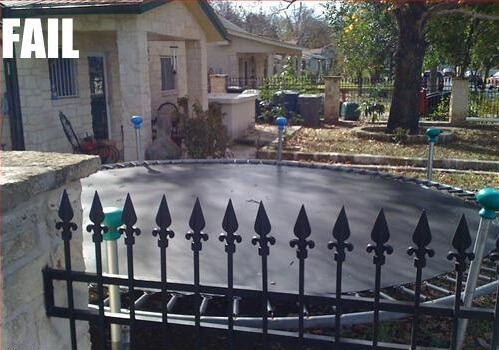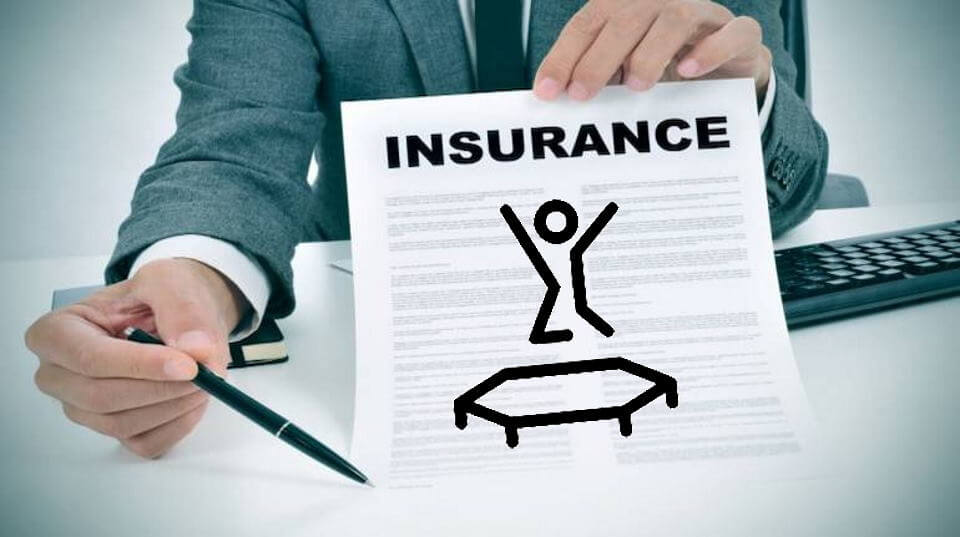Are Trampolines Covered By Homeowners Insurance? What You Need to Know.
If you’re like most parents, you probably have a trampoline in your backyard. They’re a great way to get some exercise and have some fun with your kids. But were you aware that trampolines can also cause serious accidents? And if something happens, your homeowner’s insurance policy may not cover the damages. In this post, we’ll take a look at trampoline insurance policies, and list some of the best insurance companies that will still cover you if something goes wrong.
What are the risks associated with trampolines?
Trampolines can cause a variety of injuries, including broken bones and concussions. There are reasons why trampolines fall under a category called “attractive nuisances“, meaning that kids will likely try to use them without fully understanding the risks. As accidents do happen, and you need to be aware of it, not only from falls where children might land on hard ground, which happens if you’re not using a trampoline enclosure but also strange, unexpected landings on the mat, all while doing tricks. This is why studies have shown that trampoline accidents are one of the biggest causes for young people to visit emergency rooms every year due to their high rate of injury. This is why many homeowners insurance companies won’t cover trampoline-related incidents at all!

How-To reduce risks?
There are also a few things you can do to reduce the risk of injury while using your trampoline. First, make sure that everyone who uses the trampoline is properly trained and knows how to safely jump. Second, keep the trampoline in a well-lit area so you can see any potential hazards. Finally, make sure that there are no sharp objects or other obstacles nearby that might cause someone to fall, basically at least 3ft away from any hard objects, such as brick walls, fences, or even bushes. If you follow these tips, you’ll help reduce the chances of having an accident while using your trampoline – and if something does happen, you’ll know that your homeowner’s insurance policy will have you covered.
We encourage you to read our article about trampoline safety! Without further ado, let’s jump to trampoline insurance!
Trampolines And Homeowners Insurance Policies:
Many major home insurance companies will not cover damages caused by trampoline use unless it’s part of a special endorsement added on after the policy is purchased. Even if your insurance company does cover trampolines, the amount of coverage may be very limited – usually only up to $500. This isn’t much when you consider the cost of a typical trampoline, which can range from $300-$2000 depending on the size and quality.
What should you do if you have a trampoline in your backyard?
As coverage options vary depending on the state and the insurance company, the best thing to do is contact your insurance agent and ask them about their specific policy and about the options available to you. If they don’t cover damages caused by trampolines, see if they offer an endorsement for an additional fee. If they do, it might be in one of three ways – No exclusions, Coverage with safety precautions, and Trampoline exclusion (basically meaning that policy will not cover any trampoline-related claims)
- What is the difference between “No exclusions” coverage and “Coverage with safety precautions”?
No exclusion coverage means that your homeowner’s policy does not have any restrictions on trampoline ownership. Other policies may require specific safety precautions to be in place for coverage to be offered. For example, you may be required to add a fence or locked gate around the area where your trampoline will be kept. These safety requirements are similar to the protections in place for a backyard pool. They are designed to prevent accidental use and reduce the risk of injury.
Insurance Companies That Cover Trampolines:
If you’re looking for an insurance company that will cover damages caused by a trampoline, here are some options to consider. Trampoline assurance may be covered by the homeowners’ personal responsibility. According to the National Trampoline Safety Initiative, 3% of trampoline injuries are caused by collisions. In order to reduce the number of trampoline injuries, the NTS recommends that safety pads and nets be used at all times.
- State Farm
Covers damages caused by trampolines as part of their standard policy. Trampoline assurance: Trampoline assurance may be covered by the homeowners’ personal responsibility section. State Farm offers trampoline insurance to help protect your family and your finances in the event of an accident. Trampoline insurance can help cover medical expenses, repair or replacement costs, and even provides liability coverage.
- Farmers Insurance
They do not cover trampoline accidents under their standard policy but will offer coverage with an endorsement. They will put some higher insurance limits just in case someone got hurt.
- GEICO
Geico said a net was sufficient.
- Liberty Mutual
Founded in 1912, Liberty Mutual is one of the least expensive insurance providers, with multiple discounts available, including 10% off for purchasing online in most states (California excluded). Liberty Mutual underwriting guidelines clearly state that they will not cover an unfenced trampoline.
- Nationwide
They do not have a specific endorsement for trampolines, but will generally cover them if they’re used in accordance with the manufacturer’s instructions. Nationwide Insurance includes trampolines in their coverage, but requires added safety measures, such as a high net and preventing access by placing it in a fenced area to reduce the risk of injury
- MetLife:
Trampoline insurance coverage is available for an additional fee.
- American Family
Trampolines are not covered under their standard policy but can be added for an additional fee.
As you can see, there are a variety of options when it comes to homeowners insurance and trampolines. Each company has its own rules and regulations, so be sure to read the fine print before making any decisions. If you’re a homeowner, your insurance coverage may not extend to damages. Remember, just because your insurance company does allow trampolines on your policy, it doesn’t mean that every claim involving a trampoline will be covered. Be sure to read your policy carefully and understand what is and isn’t covered.
Landlords and Tenants: Can a Tenant own a Trampoline?
Ultimately, that will be not only up to you, but on a number of factors, such as Local ordinances, requirements and regulations imposed by insurance companies, and last, State laws.
If a tenant placed a trampoline and that is in clear violation of one of the above policies, there is a number of things you can do, but the most important thing you can do is to add a clause to rental agreements which strictly prohibits adding a trampoline.
- How much will I pay to insure a trampoline?
Well, that of course depends on the insurance used, but the premium will go up, on average between $100 to $200 – to increase the liability coverage that may occur. Some insurance companies recommend additional liability coverage between $50,000 to $100,000 on top of the standard $300,000 for homes without trampolines, so based on this it’s easy to understand and calculate actual premium increase.
Regarding actual homeowners insurance policies, there are a few of them to choose from:
- Homeowners insurance covers your trampoline with no exclusions
- Homeowners insurance covers it but requires safeguards for your trampoline
- Homeowners insurance doesn’t cover your trampoline
See details on each of these possible scenarios below.
When homeowners insurance covers trampolines
Some carriers provide a “no exclusion” policy, allowing for trampoline ownership. Additionally, the carriers do not require restrictions on the trampoline, such as requiring a net around the structure.
When homeowners insurance covers trampolines but requires safeguards
Some insurance companies will insure you provided that you take certain safeguards when you install the trampoline. For example, a carrier may require that the trampoline be surrounded by a net or enclosed within a fenced-in property.
When homeowners insurance doesn’t cover trampolines
A homeowners insurance policy may flat-out exclude trampolines. In this case, the insurer will deny any trampoline-related claim and will not pay for any damage or liability claims associated with the trampoline. Additionally, some carriers take it a step further and may refuse to renew your policy if you own a trampoline, even without ever having filed a claim. These carriers refuse to run the risk of any potential trampoline claim.
If a trampoline or play structure is covered by your homeowner’s insurance policy, then this would fall under “Other Structures” (Coverage B). “Other structures” are structures on your property that are detached from your dwelling. There are three types of coverage associated with other structures.
1. Medical Liability: Coverage F covers the medical expenses of any person who does not live on your property and is accidentally injured on your property. For example, if a neighbor’s child is bouncing on the trampoline, falls off, and sustains an injury resulting in medical attention, and ultimately medical bills, a portion of these medical expenses are covered by this section of your policy. Check your policy to determine the pre-set limit of coverage. Contact your agent or insurance company to determine the appropriate amount of coverage.
2. Personal Umbrella Policy (PUP): Another avenue for coverage is through a personal umbrella policy. When purchasing a trampoline, it is a smart idea to determine if the amount of your medical liability is adequate. If not, you may choose to increase it or add PUP. This additional policy will increase your liability coverage to exceed the limits of your current homeowner’s liability coverage. If there is a claim, once the medical liability on your homeowner’s policy reaches maximum payout, the PUP will then begin to pay the remainder of the claim up to a pre-set limit. Contact your agent or insurance company to determine the appropriate amount of coverage you need. A personal umbrella policy typically costs from $150 to $300 per year and provides liability coverage, with high limits that often start at $1 million.
3. Other Structures: If your trampoline is damaged and it is caused by a covered peril as stated in your homeowner’s insurance policy, a portion of the damage may be covered. This damage is subject to the deductible and is limited to the amount set forth in your policy. For example, if a windstorm causes $3,000 worth of damage to the trampoline as determined by an adjuster, and there is a $1,000 deductible on the homeowner’s policy, then the homeowner will be responsible to pay for the first $1,000. The insurer will be responsible for the remaining $2,000.
What if your child was injured on a trampoline?

There are two distinct cases; either the child was injured on your property or an accident happened on someone else’s property.
If your child was injured in a trampoline accident on another person’s property, you may be wondering what your options are. You may be able to file a personal injury claim against the property owner. However, you will need to show that the owner was negligent in some way. If you are successful, you may be able to recover damages for your child’s injuries. The key thing here will be establishing proof through witness statements or other evidence such as surveillance footage from nearby buildings which may show what happened during an accident at home involving one’s own kids! If the homeowner didn’t have a safety net around their trampoline, if their trampoline was broken or dangerous, or if their yard wasn’t fenced in, you may have a case.
In some cases, your child’s trampoline accident could have been caused by faulty manufacturing or improper design. When this occurs, a liability lawyer may be able to file a claim against the negligent manufacturer. This is known as a product liability claim and these are some of the most complex types of cases.
Product liability claims can be divided into three main categories:
- Manufacturing defect – Your child’s trampoline accident could have been caused by a number of things. The first and most obvious is faulty manufacturing. This is a serious problem that needs to be addressed immediately. Another possibility is that your child was not using the correct safety equipment. Make sure to check the safety gear before allowing your child to play on the trampoline.
- Design defect – One of the biggest dangers of trampolines is design defects. If any part of the trampoline is not designed well, it can create a safety hazard. This is why it is so important to make sure you purchase a trampoline from a reputable manufacturer.
- Failure to warn – The failure to warn is a principle of “Product liability laws”. This principle states that manufacturers have a duty to warn consumers about potential risks associated with their products. failure to warn can result in liability for injuries or damages caused by the product.
Product liability cases can be difficult to win without an attorney. With the right legal counsel, however, you can increase your chances of success. Make sure to choose a lawyer with experience in this type of case, and don’t hesitate to ask for references.

